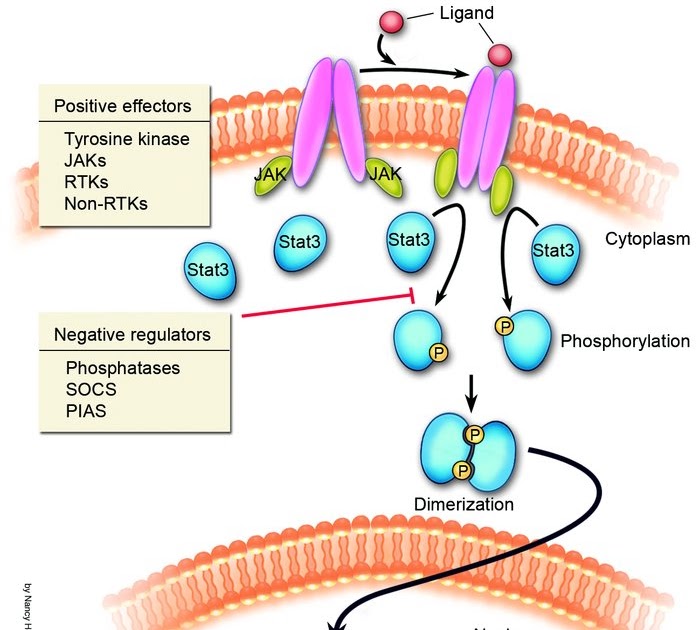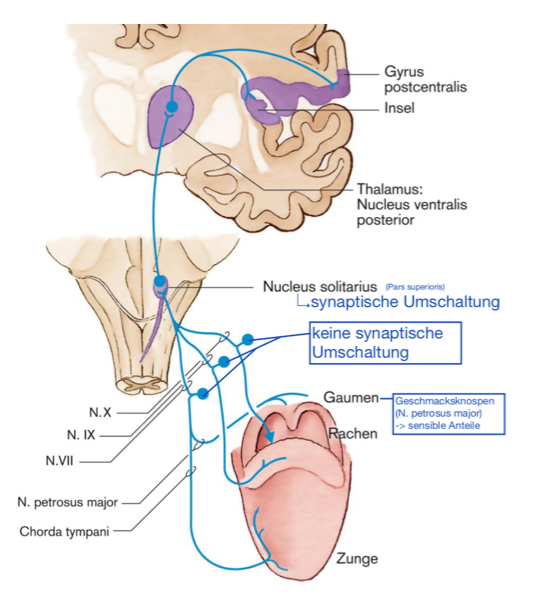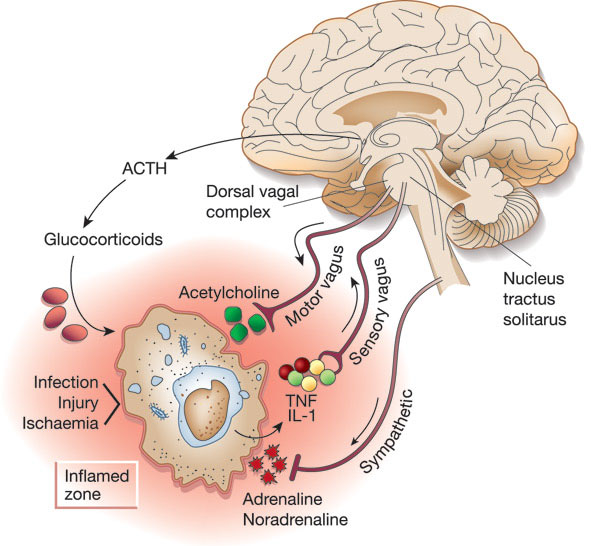
Nucleus tractus solitarii (NTS) and appetite
The nucleus of tractus solitarius, also known as the nucleus of the solitary tract or simply the solitary nucleus, is a purely sensory nucleus located in the dorsolateral medulla oblongata and lower pons.

Welche Aufgaben hat der Ncl. tractus solitarii? Anatomie ZNS Repetico
The nucleus of the solitary tract (NST) is a major sensory nucleus in the dorsal medulla that receives cardiovascular, visceral, respiratory, gustatory, and orotactile information [1,2]. The NST begins at the level of the pyramidal decussation near the cervical spinal cord and extends rostral to the caudal part of the dorsal cochlear nucleus [3]. Caudally, the NST spans the midline forming the.

Activation of Phox2bExpressing Neurons in the Nucleus Tractus Solitarii Drives Breathing in
Pulmonary stretch receptor afferents activate excitatory amino acid receptors in the nucleus tractus solitarii in rats. J. Physiol. 464, 725-745 [PMC free article] [Google Scholar] Bonham A. C., McCrimmon D. R. (1990). Neurones in a discrete region of the nucleus tractus solitarius are required for the Breuer-Hering reflex in rat. J. Physiol.

Nucleus Tractus Solitarius Medical mnemonics, Medical anatomy, Dentistry
The nucleus of the solitary tract, also known as the nucleus tractus solitarius (pl. solitarii) is a pair of cell bodies found in the brainstem. This structure, along with its tract (the solitary tract or tractus solitarius), has far reaching impacts on many homeostatic systems within the body.

Location of neurons in nucleus tractus solitarii (NTS) that displayed... Download Scientific
The brainstem has three primary sensory columns of nuclei that form the source of the function of cranial nerves. Each one has a function that gets exerted through cranial nerves. On the lateral side of the brainstem are the sensory nuclei. The visceral sensory part of the brainstem has a single nucleus found in the medulla oblongata, the nucleus solitarius, which is located lateral to the.
:watermark(/images/logo_url.png,-10,-10,0):format(jpeg)/images/anatomy_term/nucleus-of-solitary-tract-3/WcbVpX3d3rthf6fMlX8H2w_Solitary_nucleus_1.png)
Mixed cranial nerves Anatomy, course, fibers, functions Kenhub
The nucleus tractus solitarius (NTS) is the principal visceral sensory nucleus in the brain and comprises neurochemically and biophysically distinct neurons located in the dorsomedial medulla oblongata.

(PDF) Hypoxia activates nucleus tractus solitarii neurons projecting to the paraventricular
The nucleus of the solitary tract (solitary nucleus, nucleus tractus solitarii [NTS]), located in the dorsomedial medulla, is the first relay station for general visceral and taste afferents carried by the cranial nerves and has a critical role in the initiation and integration of a wide variety of reflexes controlling cardiovascular function, respiration, and gastrointestinal motility.

[Figure, Nucleus Solitarius. Image courtesy S Bhimji MD] StatPearls NCBI Bookshelf
The solitary nucleus (also called nucleus of the solitary tract, nucleus solitarius, or nucleus tractus solitarii (SN or NTS)) is a series of sensory nuclei (clusters of nerve cell bodies) forming a vertical column of grey matter in the medulla oblongata of the brainstem. It receives general visceral and/or special visceral inputs from the facial nerve (CN VII), glossopharyngeal nerve (CN IX.

Location of neurons in nucleus tractus solitarii (NTS) that displayed... Download Scientific
The nucleus tractus solitarius (NTS) is subdivided into nine subnuclei based on their cellular morphology. The NTS receives afferent input from the vagus, glossopharyngeal, and facial nerves.

Alpha2adrenoceptor and adenosine A1 receptor within the nucleus tractus solitarii in
The nucleus tractus solitarii (NTS) has long been considered as the first central relay for gustatory and visceral afferent informations only. However, data obtained during the past ten years, with neuroanatomical, biochemical and electrophysiological techniques, clearly demonstrate that the NTS is.

Leptin Signaling in the Nucleus Tractus Solitarii Increases Sympathetic Nerve Activity to the
In this issue of The Journal of Physiology, Bailey and colleagues ( Bailey et al. 2007) combine neuroanatomical tracing techniques with an electrophysiological approach in horizontal brainstem slice preparations to identify and characterize NTS neurons that project selectively to either the paraventricular nucleus of the hypothalamus (PVN) or th.

Activation of Phox2bExpressing Neurons in the Nucleus Tractus Solitarii Drives Breathing in
We describe a major role for the nucleus tractus solitarii (NTS) as a site for integrating nociceptive and cardiorespiratory afferents. Since cardiorespiratory and nociceptive afferents terminate in the NTS, this nucleus offers a powerful opportunity for central modulation. We show that the NTS plays a major role in mediating the reflex.

Nucleus Tractus Solitarius
The solitary nucleus receives sensory inputs from visceral organs of cardiovascular, respiratory, genital and digestive systems (Hubscher and Berkley, 1994, 1995 ). Information to this nucleus is carried by spinal neurons as well as by the glossopharyngeal and vagus nerves ( Hubscher and Berkley, 1995 ). The cells of origin in the spinal cord.

Location of the nucleus tractus solitarius (NTS) regions in the medulla... Download Scientific
It is well known that breathing introduces rhythmical oscillations in the heart rate and arterial pressure levels. Sympathetic oscillations coupled to the respiratory activity have been suggested as an important homeostatic mechanism optimizing tissue perfusion and blood gas uptake/delivery. This respiratory-sympathetic coupling is strengthened in conditions of blood gas challenges (hypoxia.

Nucleus tractus solitarii (NTS) Introduction
Bradycardia following injection of 6-hydroxydopamine into the intermediate portion of nucleus tractus solitarius medialis. Brain Res. 1981; 206:415-420. Crossref Medline Google Scholar; 5 Biaggioni I, Whetsell WO, Jobe J, Nadeau JH. Baroreflex failure in a patient with central nervous system lesions involving the nucleus tractus solitarii.

Interactions between NTS, brain efferences, cortical structures and... Download Scientific Diagram
The nucleus tractus solitarius (NTS) is a key brainstem structure relaying interoceptive peripheral information to the interrelated brain centres for eliciting rapid autonomic responses and for shaping longer-term neuroendocrine and motor patterns. Structural and functional NTS' connectivity has been extensively investigated in laboratory animals.